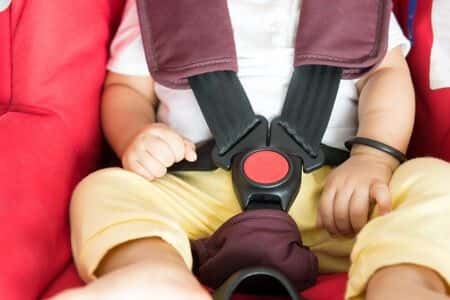Defectively Designed Car Seat Leaves Child With Concussion
Updated on
This case involves an allegedly defective child’s car seat. The plaintiff, a thirty-six-year-old male, was driving home with his five-year-old son and two-year-old daughter in a sedan. He took an unfamiliar, local route to avoid increased tolls. He came to a stop sign, stopped, and proceeded to go through. He was then hit by an SUV on the front (by the right bumper) of his car. Both cars sustained minor damage, but no one was severely hurt. When the plaintiff checked on his children, his daughter indicated that her head hurt and she was throwing up. After checking with a doctor, it was revealed that she was suffering from a concussion due to hitting her head on the protective shield plate of her car seat. Investigators say the car seat was properly secured by the plaintiff.
Question(s) For Expert Witness
1. How can a protective shield plate on a child's car seat cause a concussion, and is this a reasonable danger in a minor car accident?
Expert Witness Response
 Five point harness seats are generally considered the safety standard in motor vehicles; this design is even mandated in NASCAR vehicles. The five different straps hold young children securely to the seat, minimizing the risk of ejection in the event of a car accident. Despite the fact that the five-point harness is the safest design, some manufacturers continue to use outdated, unsafe child safety seats with one- and three-point restraints. In T-shield seats, the straps that go over the child’s shoulder and between their legs are attached to a hard plastic or molded rubber shield. The shield is not snug, but stays several inches in front of the body. In accidents, the space between the child and the shield actually allows for a gain in momentum before hitting the restraint. The shield’s positioning and material puts children in risk of trauma to the head, chest, and abdomen. In the case of a crash, the T-shield may also impact the top of the child’s throat and puts pressure on back tissue, possibly leading to back and spinal cord injury. I would need to examine the specifics of the car seat in question, but given the circumstances of the case (with it being a relatively minor car accident and the child being in a T-shelf seat), the associated harm was not reasonable and likely caused by the design of the seat. I am also aware of other cases where similar injuries have occurred from minor accidents. I have over thirty years of engineering experience, analyzing automobile accidents, the design of seating (for both adults and children), and seat belt placement.
Five point harness seats are generally considered the safety standard in motor vehicles; this design is even mandated in NASCAR vehicles. The five different straps hold young children securely to the seat, minimizing the risk of ejection in the event of a car accident. Despite the fact that the five-point harness is the safest design, some manufacturers continue to use outdated, unsafe child safety seats with one- and three-point restraints. In T-shield seats, the straps that go over the child’s shoulder and between their legs are attached to a hard plastic or molded rubber shield. The shield is not snug, but stays several inches in front of the body. In accidents, the space between the child and the shield actually allows for a gain in momentum before hitting the restraint. The shield’s positioning and material puts children in risk of trauma to the head, chest, and abdomen. In the case of a crash, the T-shield may also impact the top of the child’s throat and puts pressure on back tissue, possibly leading to back and spinal cord injury. I would need to examine the specifics of the car seat in question, but given the circumstances of the case (with it being a relatively minor car accident and the child being in a T-shelf seat), the associated harm was not reasonable and likely caused by the design of the seat. I am also aware of other cases where similar injuries have occurred from minor accidents. I have over thirty years of engineering experience, analyzing automobile accidents, the design of seating (for both adults and children), and seat belt placement.
About the author
Michael Talve, CEO
Michael Talve stands at the forefront of legal innovation as the CEO and Managing Director of Expert Institute. Under his leadership, the Expert Institute has established itself as a vital player in the legal technology arena, revolutionizing how lawyers connect with world-class experts and access advanced legal technology. Michael's role involves not only steering the company's strategic direction but also ensuring the delivery of unparalleled intelligence and cutting-edge solutions to legal professionals. His work at Expert Institute has been instrumental in enhancing the capabilities of attorneys in case preparation and execution, making a significant impact on the legal industry's approach to expert consultation and technological integration. Michael's vision and execution have positioned the Expert Institute as a key facilitator in the intersection of law and technology.
Subscribe to our newsletter
Join our newsletter to stay up to date on legal news, insights and product updates from Expert Institute.
Sign up nowFind an expert witness near you
What State is your case in?
Subscribe to our newsletter
Join our newsletter to stay up to date on legal news, insights and product updates from Expert Institute.



